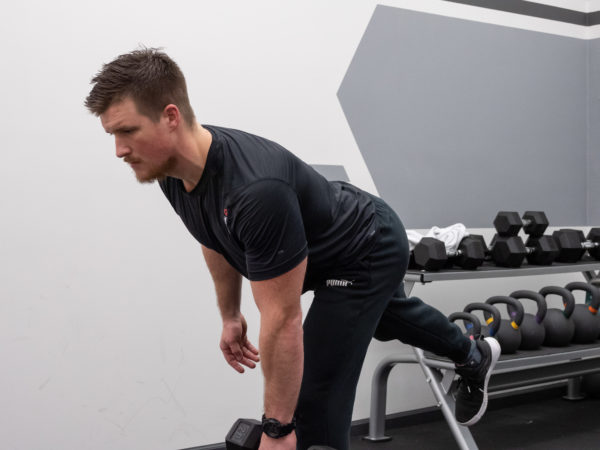Ah, the pains of low back pain. You set up under the barbell, get tight, unrack, and physically feel those vertebrae compressing under the weight. Sometimes it’s not even an injury; sometimes, no matter how much we warm up or how well we’re taking care of ourselves, we have days when our low backs are just… stiff.
And then, there are those persistent injuries. We’re doing everything our doctor tells us to do — and avoiding everything they tell us not to do — but still, we long to squat.
Fortunately, getting under a barbell that weighs a few times more than we do isn’t our only option for building massive leg strength and getting your fill of squatting. Enter unilateral squats.
Unilateral squats can mean a lot of things: Bulgarian split squats, for example, or pistol squats. And those options are great for building solid lower body and core strength.
But for the purposes of this article, unilateral squats simply mean a squat wherein the two feet aren’t alongside one another: the non-weight bearing foot can be a couple of feet behind (eg. a lunge), elevated on a bench behind you (eg. a Bulgarian split squat), or hovering in front of you (eg. a pistol squat).
The peak vertical ground reaction force — what we use as propulsion to control our lifts — is greater in unilateral squats than regular, bilateral squats.(1) As a result, unilateral squats can create significantly higher barbell velocity, which can be a great way for you over there with your low back pain to generate a lot of power.
Editor’s note: The content on BarBend is meant to be informative in nature, but it shouldn’t take the place of advice and/or supervision from a medical professional. The opinions and articles on this site are not intended for use as diagnosis, prevention, and/or treatment of health problems. Speak with your physician if you have any concerns or before beginning any new dietary regimen or exercise routine.
[Learn more: 4 exercises to strengthen your low back]

Just As Good For Leg Development
“But,” I can hear your objecting, “you have to use so much less weight with unilateral squats. How will I ever get my pump?”
Well, first: lower weight means higher reps, which means you can definitely get that pump. But second, unilateral squats will fire your hamstrings, calves, hips, and abdominals just as much as bilateral squats.(1) We promise.
Sure, your quadricep muscles may not get as much out of unilateral squats as they do your regular old two-footers, but get yourself into some leg extensions and while your back is recovering, you’ll still get that quad development you need to rip your board shorts when you flex.
[Learn the best movement for your needs: Bulgarian split squat vs. Lunge vs. Step up!]
Do It For Your Back
One thing unilateral squats aren’t as good at as bilateral squats: activating your erector spinae muscles.(1) But when your lower back is in pain, that’s not a bad thing — it’s a wonderful thing. Because while unilateral squats will rock your abs, they’ll leave your low back with much less stress than bilateral squats do. The reduced stress on your low back means you can start to add poundage to your unilateral squats (instead of begrudgingly taking it away from your bilaterals).
So, when it’s leg day and you have low back pain: first, see a doctor and make sure it’s actually safe for you to be lifting at all. If it is, go at it with this sample workout (modify, of course, to suit your body and needs).

Sample Unilateral Squat Workout
Barbell or Dumbbell Loaded Unilateral Squat
Choose barbell/dumbbell and foot position according to your familiarity with the moves and comfort level. Go conservative on the weight, and work up to 4 sets of 8 (per leg) with a 90-second rest in between.
Dumbbell Loaded Lunges
Be sure to keep your core engaged as you power through another 4 sets of 8 (per leg). As an added bonus, try to keep the dumbbells in your hands for as long as you can during rest (why not get a little extra grip work in there?).
Single Leg Romanian Deadlift (dumbbell)
We’re going for another set of 4×8 per leg here, keeping the same rest scheme. Be sure you’re hinging at the hips instead of curving your back down toward the ground, and be sure you don’t dip the weight too far past your knee. You don’t need to go that far down to get a wild workout for your hamstrings.
[See our guide to the single leg deadlift.]

Unilateral Leg Extensions
We’re going lighter here to make sure your low back doesn’t take on any accidental, additional strain. So go for 4×15, and keep yourself honest: why kip up your legs to incomplete extension with a too-heavy weight when you can get 15 solid af reps in there?
Seated Calf Raises
I know it’s tempting to jump under the standing calf raise machine, but you probably don’t want those extra compression forces on your spine right now. So get yourself into seated calf raises, again for 4×15. Go slow, emphasizing each peak and crest. Don’t cheat yourself: treat yourself (yeah, I said that unironically).
Wrapping Up
These largely unilateral moves — all designed to power up your unilateral squat — will get you squatting safely even with some low back pain. Just remember to listen to your body, and that programming appropriately for low back pain is much more sustainable than “powering through” it.
Reference
1. Eliassen W, et al. COMPARISON OF BILATERAL AND UNILATERAL SQUAT EXERCISES ON BARBELL KINEMATICS AND MUSCLE ACTIVATION. Int J Sports Phys Ther. 2018 Aug;13(5):871-881.
